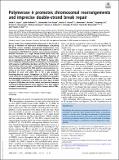| dc.contributor.author | Layer, Jacob V | |
| dc.contributor.author | Debaize, Lydie | |
| dc.contributor.author | Van Scoyk, Alexandria | |
| dc.contributor.author | House, Nealia C | |
| dc.contributor.author | Brown, Alexander J | |
| dc.contributor.author | Liu, Yunpeng | |
| dc.contributor.author | Stevenson, Kristen E | |
| dc.contributor.author | Hemann, Michael | |
| dc.contributor.author | Roberts, Steven A | |
| dc.contributor.author | Price, Brendan D | |
| dc.contributor.author | Weinstock, David M | |
| dc.contributor.author | Day, Tovah A | |
| dc.date.accessioned | 2021-10-27T20:05:32Z | |
| dc.date.available | 2021-10-27T20:05:32Z | |
| dc.date.issued | 2020 | |
| dc.identifier.uri | https://hdl.handle.net/1721.1/134551 | |
| dc.description.abstract | © 2020 National Academy of Sciences. All rights reserved. Recent studies have implicated DNA polymerases θ (Pol θ) and β (Pol β) as mediators of alternative nonhomologous end-joining (Alt-NHEJ) events, including chromosomal translocations. Here we identify subunits of the replicative DNA polymerase δ (Pol δ) as promoters of Alt-NHEJ that results in more extensive intrachromosomal mutations at a single double-strand break (DSB) and more frequent translocations between two DSBs. Depletion of the Pol δ accessory subunit POLD2 destabilizes the complex, resulting in degradation of both POLD1 and POLD3 in human cells. POLD2 depletion markedly reduces the frequency of translocations with sequence modifications but does not affect the frequency of translocations with exact joins. Using separation-of-function mutants, we show that both the DNA synthesis and exonuclease activities of the POLD1 subunit contribute to translocations. As described in yeast and unlike Pol θ, Pol δ also promotes homology-directed repair. Codepletion of POLD2 with 53BP1 nearly eliminates translocations. POLD1 and POLD2 each colocalize with phosphorylated H2AX at ionizing radiation-induced DSBs but not with 53BP1. Codepletion of POLD2 with either ligase 3 (LIG3) or ligase 4 (LIG4) does not further reduce translocation frequency compared to POLD2 depletion alone. Together, these data support a model in which Pol δ promotes Alt-NHEJ in human cells at DSBs, including translocations. | |
| dc.language.iso | en | |
| dc.publisher | Proceedings of the National Academy of Sciences | |
| dc.relation.isversionof | 10.1073/pnas.2014176117 | |
| dc.rights | Article is made available in accordance with the publisher's policy and may be subject to US copyright law. Please refer to the publisher's site for terms of use. | |
| dc.source | PNAS | |
| dc.title | Polymerase δ promotes chromosomal rearrangements and imprecise double-strand break repair | |
| dc.type | Article | |
| dc.contributor.department | Koch Institute for Integrative Cancer Research at MIT | |
| dc.relation.journal | Proceedings of the National Academy of Sciences of the United States of America | |
| dc.eprint.version | Final published version | |
| dc.type.uri | http://purl.org/eprint/type/JournalArticle | |
| eprint.status | http://purl.org/eprint/status/PeerReviewed | |
| dc.date.updated | 2021-07-16T14:50:58Z | |
| dspace.orderedauthors | Layer, JV; Debaize, L; Van Scoyk, A; House, NC; Brown, AJ; Liu, Y; Stevenson, KE; Hemann, M; Roberts, SA; Price, BD; Weinstock, DM; Day, TA | |
| dspace.date.submission | 2021-07-16T14:51:00Z | |
| mit.journal.volume | 117 | |
| mit.journal.issue | 44 | |
| mit.license | PUBLISHER_POLICY | |
| mit.metadata.status | Authority Work and Publication Information Needed | |
